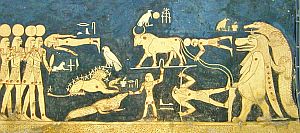
|
|
EgyptAstronomy
|
|


Egyptian astronomy dates back to the fifth millennium BC, two thousand years further
than other ancient cultures such as Mesopotamia or
China. Egyptian culture depended on the annual floods of the Nile. Exact time
keeping was essential to forecast the flood and for that, precise observations of the stars were necessary. As a result, the usage of a 365-day calendar
in Egypt dates back to at least the third century BC, making the Egyptian calendar the oldest
365-day calendar in the eastern hemisphere.
 The primary focus of this site is not astronomy, but Star Lore, which is folklore based upon stars and star patterns. We try to create a collection of mythical stories about stars and constellations from all over the world. However, to better understand and interpret the stories, a brief history of the astronomy of different cultures might be helpful.  This is by no means a scientific paper on the history of Egyptian astronomy, but merely an illustrated collection of highlights of that history, along with some links to what we think are reliable sources on the subject.  There have been numerous attempts to interpret Egyptian star charts in hieroglyphic text, but the results are controversial. We found two extensive studies online, one by Alessandro Berio (second source here) and one by Josť Lull and Antonio Belmonte. Both are intriguing, but we are in no position to evaluate them. We also found an extensive interpretation of the works of S.A. Mackey by Antonios Goyios. |


|
|
This portion of our site is about the history of ancient Egyptian astronomy.
 Click here to discover the world of Egyptian Star Lore. |


Bits of History of Egyptian Astronomy |


|
|
Nabta Playa
The stone circles of Nabta Playa in southern Egypt date back to
the 5th millennium BC - two thousand years before the reign of the Pharaohs. There are (disputed) claims that the circles represent
Calendar Circles, indicating the rising of certain stars and the direction of the summer solstice sunrise.
|
 Nabta Playa Stone Circle
Nabta Playa Stone Circle(reconstructed at Aswan Nubia museum) Source: Wikipedia |


|
|
The Decans (ca. 2100 BC)
The Decans were 36 groups of stars that rose consecutively on the horizon throughout each earth
rotation. The rising times of these stars were used as star clocks since about 2100 BC.
|

|


|
|
The Book of Nut (ca. 1850 BC)
Dating back to the 12th Dynasty and to Pharaoh
Senusret III, the
The Fundamentals of the Course of the Stars, was named the Book of Nut after the
Egyptian sky goddess.
|
 Goddess Nut, supported by the god of air Shu;
Goddess Nut, supported by the god of air Shu;by E. A. Wallis Budge Source: Wikipedia |


|
|
Senenmut's Tomb (1534 BC)
The tomb of Pharaoh Senenmut contains the oldest form of astronomical ceiling decoration in ancient
Egypt. The ceiling shows a Celestial Diagram consisting of a northern and a southern panel which depicted circumpolar constellations.
|

|


|
|
The Sundial (ca. 1500 BC)
The earliest sundials known from the archaeological record are shadow clocks
dated at about 1500 BC from ancient Egyptian and Babylon.
|
 World's oldest sundial
World's oldest sundialSource: Wikipedia |


|
|
Seti I's Tomb (ca. 1279 BC)
The second best preserved astronomical ceiling decoration in Egyptian tombs is that of Pharaoh
Seti I. It shows personified representations of stars and constellations which are still open to
interpretation.
|
 Astronomical ceiling of Seti I tomb
Astronomical ceiling of Seti I tombSource: Wikipedia |


|
|
Interpretation of Egyptian constellations
The Decans were an indigenous Egyptian development. Most likely, the do not resemble any of the know Mesopotamian or Greek constellations. While there
have been many documented efforts, there is no confirmed interpretation that links certain hieroglyphs in Decan tables without a doubt to specific stars.
|


|
|
The Dendera Zodiac (ca. 50 BC)
Following the conquests of Alexander the Great in the 3rd century BC, Egyptian
astronomy (and astrology) merged with that of ancient Greece and
Mesopotamia.
In the first century AD, Claudius Ptolemy made Alexandria in Egypt the center of Hellenistic astronomy. Egypt's legacy also lived on in the works of Arab astronomers such as al Sufi. |
 Drawing of the Dendera Zodiac by
Drawing of the Dendera Zodiac byProsper Jollois and Edouard Devilliers Source: Napoleon and the Scientific Expedition to Egypt |


In 331 BC, Alexander the Great founded Alexandria.
 From that time on, Egyptian astronomy merged with that of ancient Greece. |

 |
Back to ancient Mesopotamia | Forward to ancient Greece |
 |


|
Back to Star Lore |

Back to History |
Back to Space Page |
Back to English |
 Back to Start Page |